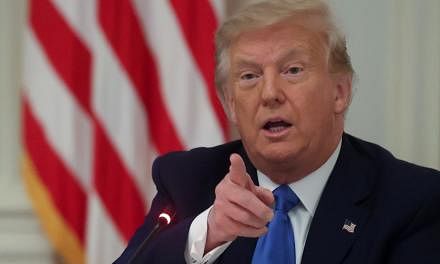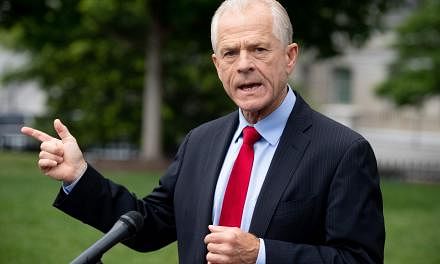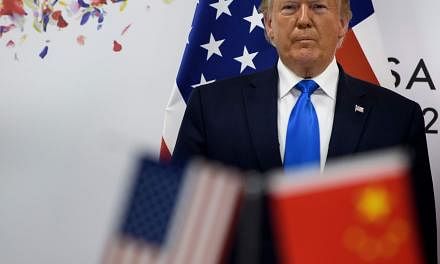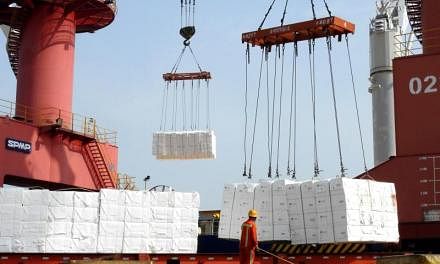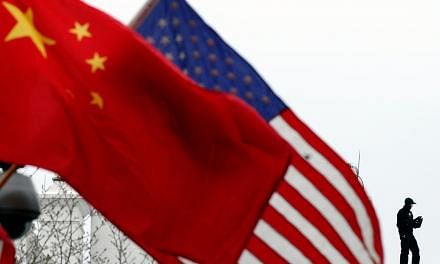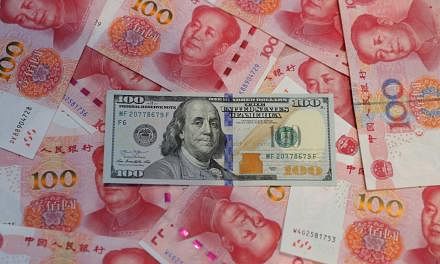WASHINGTON (BLOOMBERG) - As the US-China trade fight deepens, the two superpowers - one incumbent and one rising - are sizing each other up and deciding whether they can coexist.
China and the US ended talks in Washington last Friday (May 10) with no deal after President Donald Trump raised tariffs on more than US$200 billion (S$273 billion) in goods from the country and China vowed to retaliate. The moves create new barriers between the world's largest economies and further complicates a relationship which is increasingly strained over flashpoints that include trade, technology, Taiwan and the South China Sea.
Provocations have mounted in recent weeks.
Last Monday, two US warships sailed near disputed islands in the South China Sea, challenging Beijing's claims for the third time this year while the US on Thursday barred China Mobile Ltd. from the US market citing espionage concerns.
Behind each incremental move, Beijing sees a conspiracy to hold back China's development and block its rise.
In Washington, many fear a powerful rival whose ascent could unleash risks that can't be contained. In both countries, some are asking whether the mistrust has escalated beyond the point of no return and could last well beyond Trump's time in office.
Ms Bonnie Glaser, a China specialist at the Center for Strategic and International Studies in Washington, said the competitive dynamic is here to stay so long as Beijing's international influence continues to grow.
"The narrowing of the power gap between the US and China will embolden Beijing to be more assertive in defending and advancing its interests. The US will be compelled to respond," Ms Glaser said.
Outside of trade, the most visible catalyst for growing tensions is the Trump administration's increasing willingness to push China on sensitive areas, including offers of greater military support to Taiwan and harsh rebukes of China's policies in Xinjiang and Tibet.
It has lobbied allies to keep Chinese tech giant Huawei Technologies Co out of future 5G telecommunications networks while a US State Department official said recently that China represents "a long-term threat" and a "great power competitor." Analysts see a broad clash taking shape.
'NEW COLD WAR'
"The ultra-conservatives and hawks in the United States really want to push the United States and China towards a new Cold War," said Mr Wang Dong, secretary-general of the Pangoal Institution, a Beijing-based research group. He called it "a disturbing and perhaps dangerous development."
Mr Benn Steil, director of the international economics programme at the Council on Foreign Relations, said that new rivalry between the US and China for control of everything from global trade routes to cyberspace will drive the relationship in the years to come.
"The heady era of global economic integration is gone," Mr Steil said. "It's over."
Indeed, Trump aides have said trade tariffs are aimed at forcing change in China as well as encouraging a shift in supply chains away from a strategic rival that has take a growing share of global manufacturing over the past three decades.
The two countries held high-level discussions in Washington on Thursday and Friday over trade that ended without a deal but avoided a breakdown. The US gave its bottom line, saying Beijing had three to four weeks more to reach an agreement before the Trump administration enacts additional tariffs on US$325 billion of Chinese imports not currently covered by punitive duties, according to two people familiar with the talks.
Support in the US for a more hard-line approach toward China often splits lawmakers along regional lines instead of political lines. While Republicans from farm states are warning about the impact of tariffs on agriculture, some Democrats, such as the party's Senate leader Chuck Schumer are urging Mr Trump to "hang tough" in negotiations with China. Democratic presidential candidate Bernie Sanders, a Vermont senator, has highlighted his vote against giving China favoured nation status on trade.
Burgeoning tensions are also a result of Beijing's increasingly boisterous foreign policy. Since coming to office in 2012, President Xi Jinping has asserted China's territorial claims in the South and East China seas more vigorously than his predecessors, launched a multi-billion dollar infrastructure spending project and said he'll make China a "world-class" military power by 2050. He's also been willing to punish countries - most recently Canada - which publicly side with Washington.
'ON STEROIDS'
Mr Xi's policies have put existing competitive dynamics between the countries "on steroids," according to Mr Dennis Wilder, a professor at Georgetown University and former senior director for Asia on the National Security Council.
The result is that Mr Xi has "galvanised US and Western political elites to respond to this challenge to the existing international world order."
Like Mr Trump, China's leaders also need to play to domestic audiences and backing down in the face of a rival superpower is not a good look at home. Commentators this week likened Vice Premier Liu He, who has been negotiating over trade with Washington, to a colonial era official who signed a much maligned treaty with Japan more than a century ago.
Of course there's a lot still holding the two sides together - especially economic interdependence. The list of items hit by the higher tariffs included everyday consumer items from baby furniture to refrigerators. For some of these, over nine out of every 10 purchased by American shoppers are Chinese-made. As the tariffs impact US consumers, Mr Trump might be tempted to de-escalate the trade conflict.
If US voters elect a new president in 2020, relations might become less combustible. Still, the underlying drivers of strategic competition would likely remain, said CSIS's Glaser.
"These include the battle over technology and China's resolve to control the maritime areas in the first and second island chains and ultimately become the preeminent power in Asia," Ms Glaser said.


